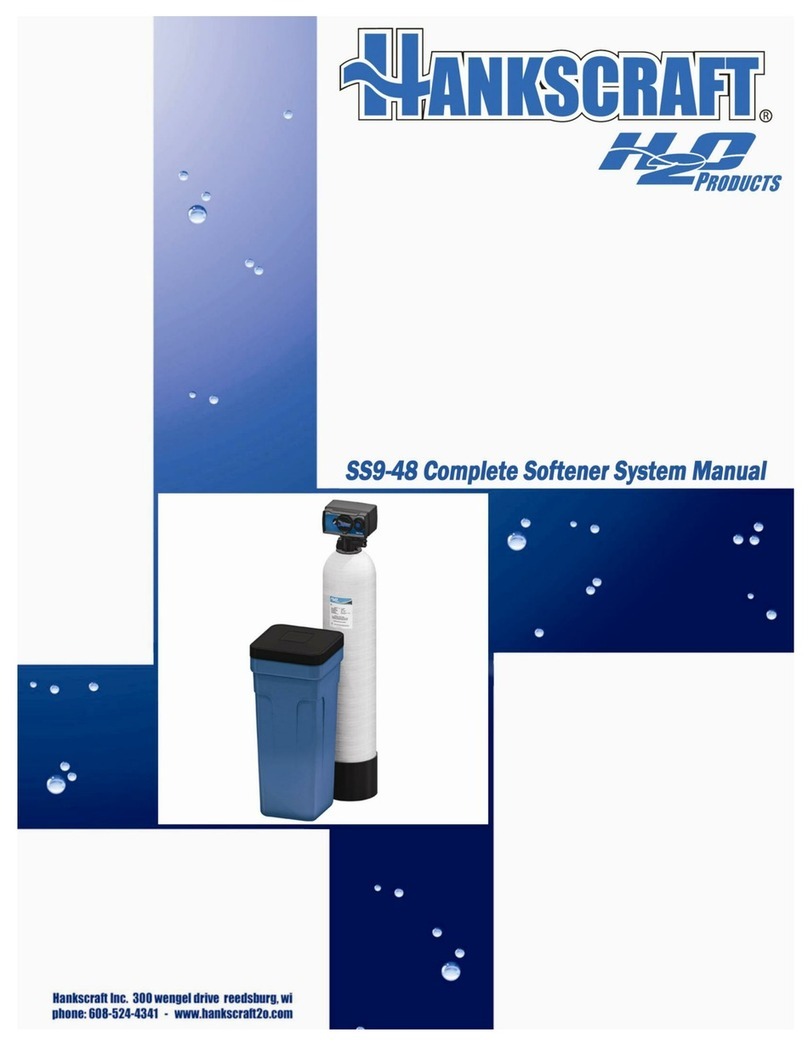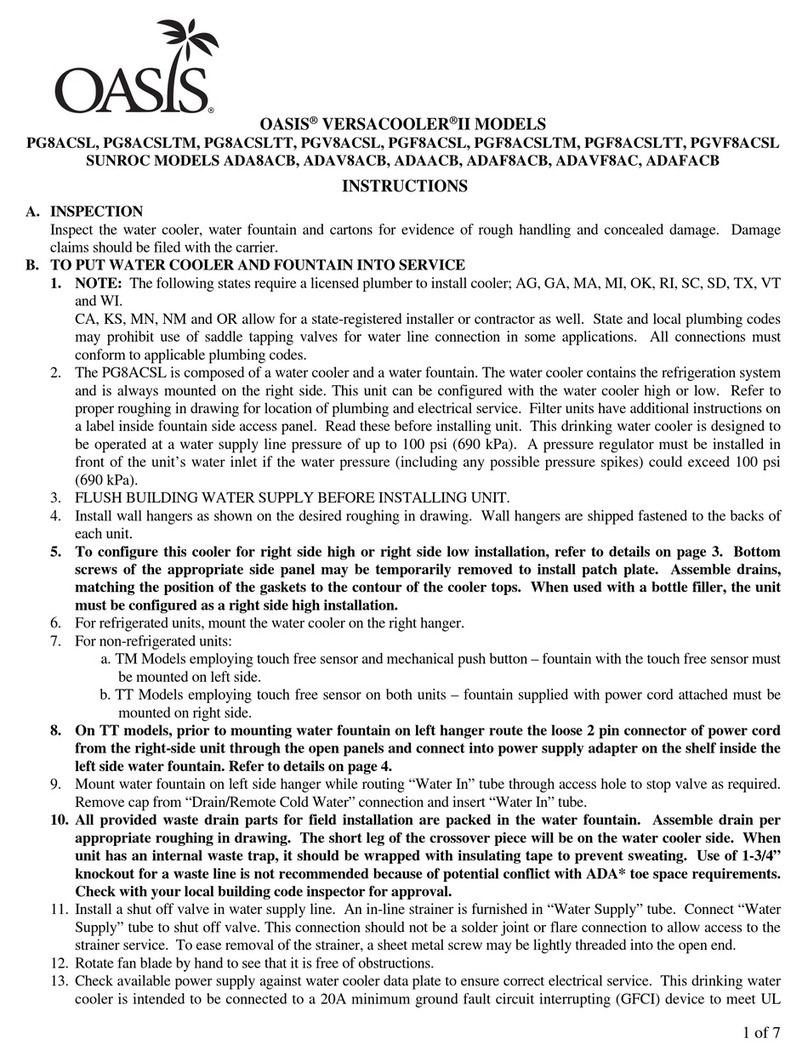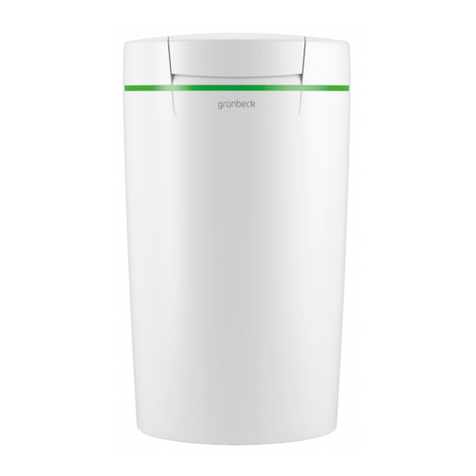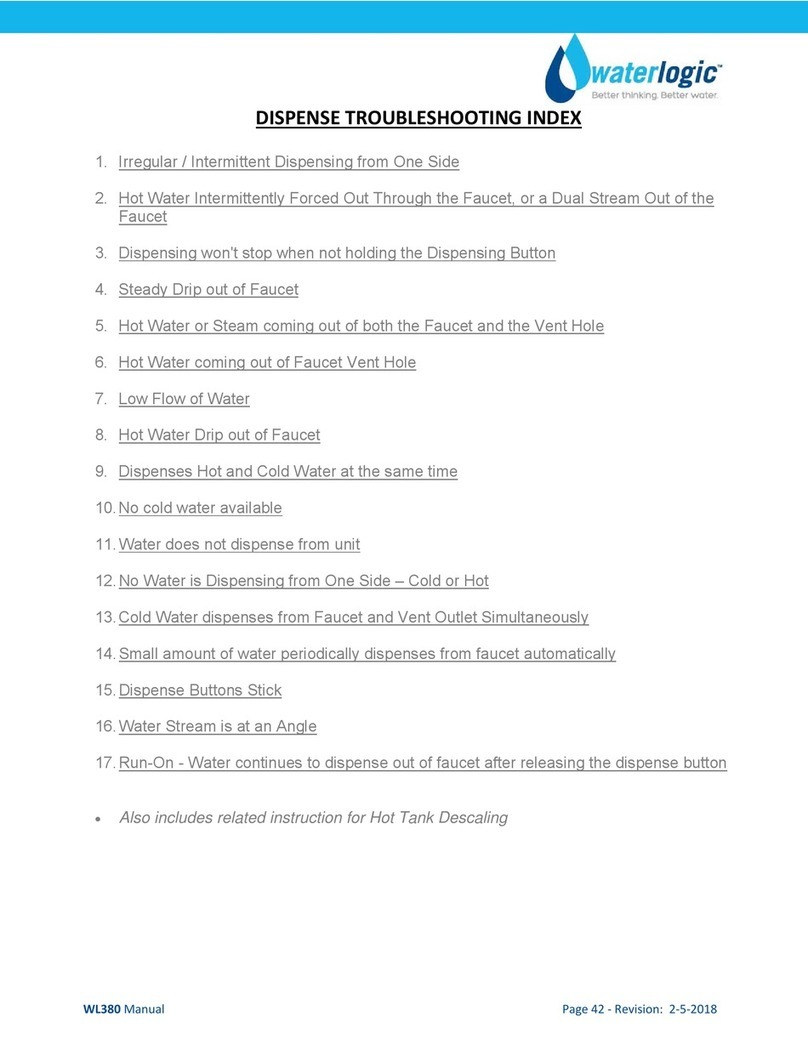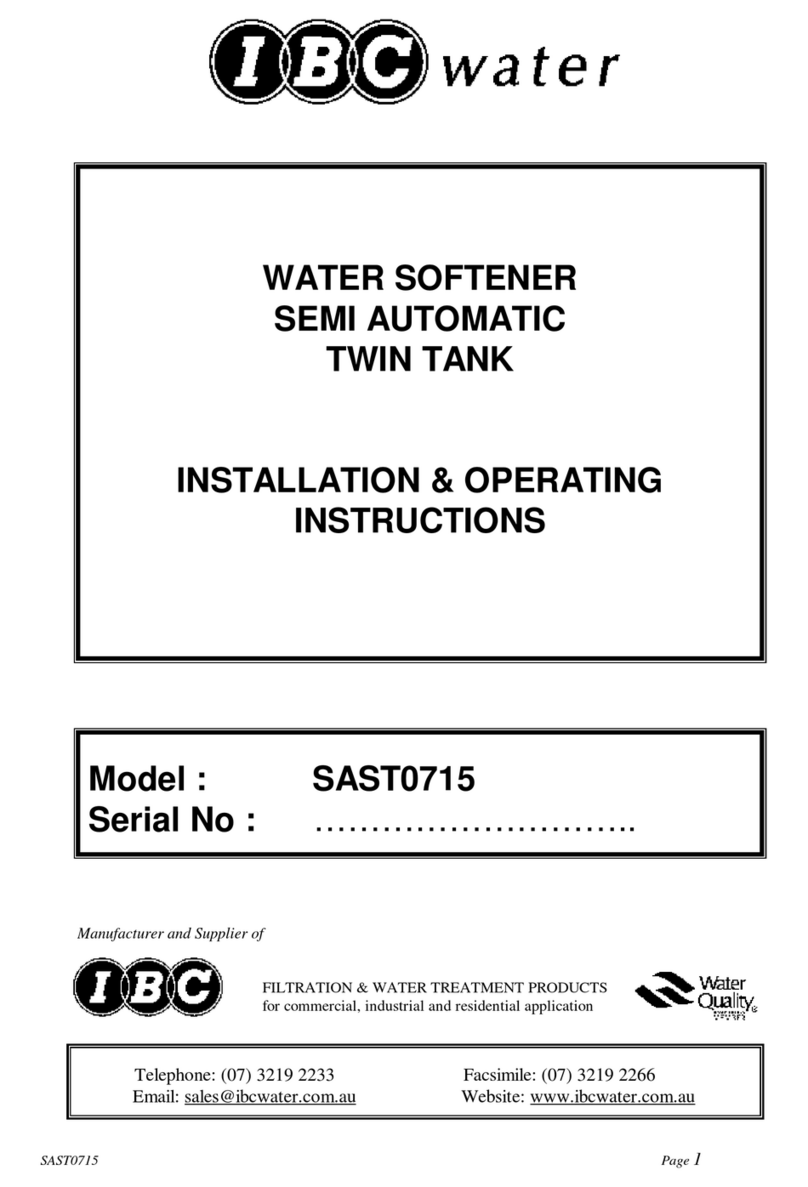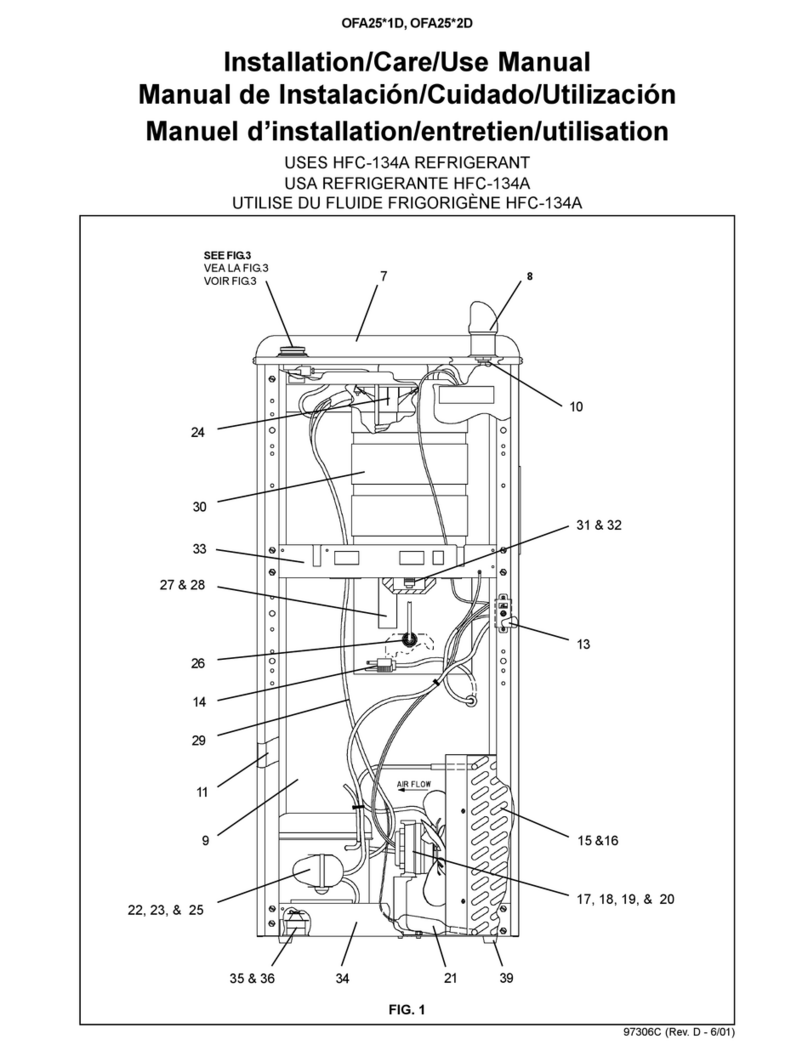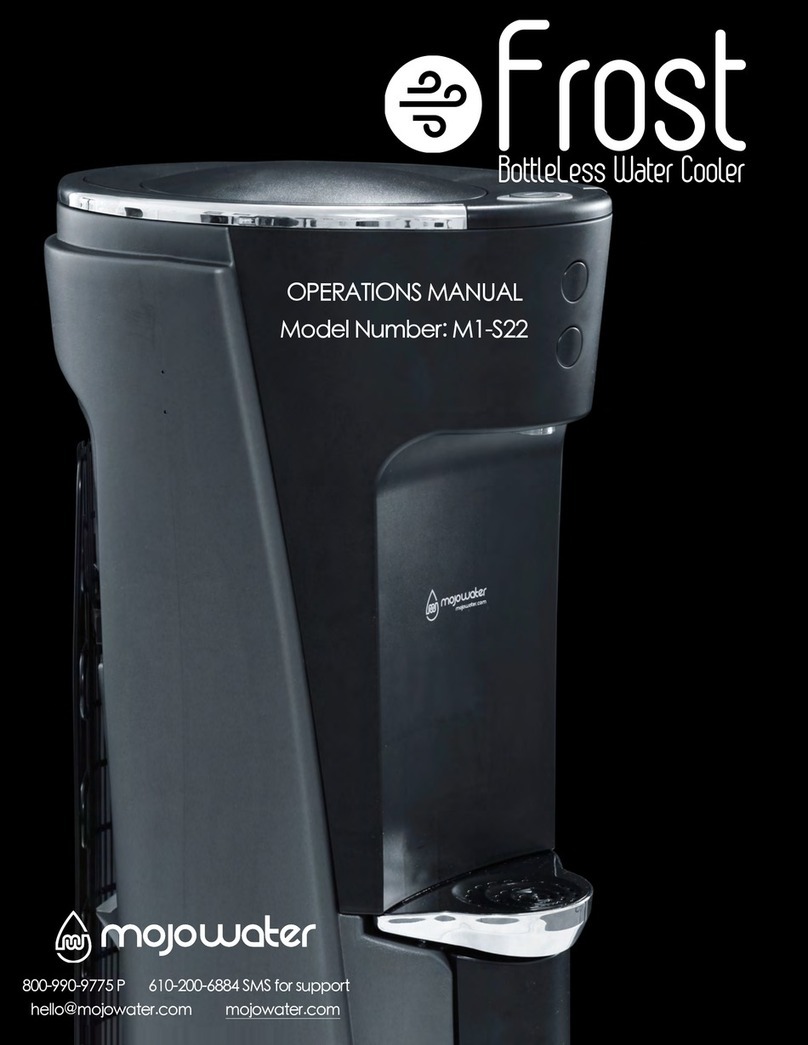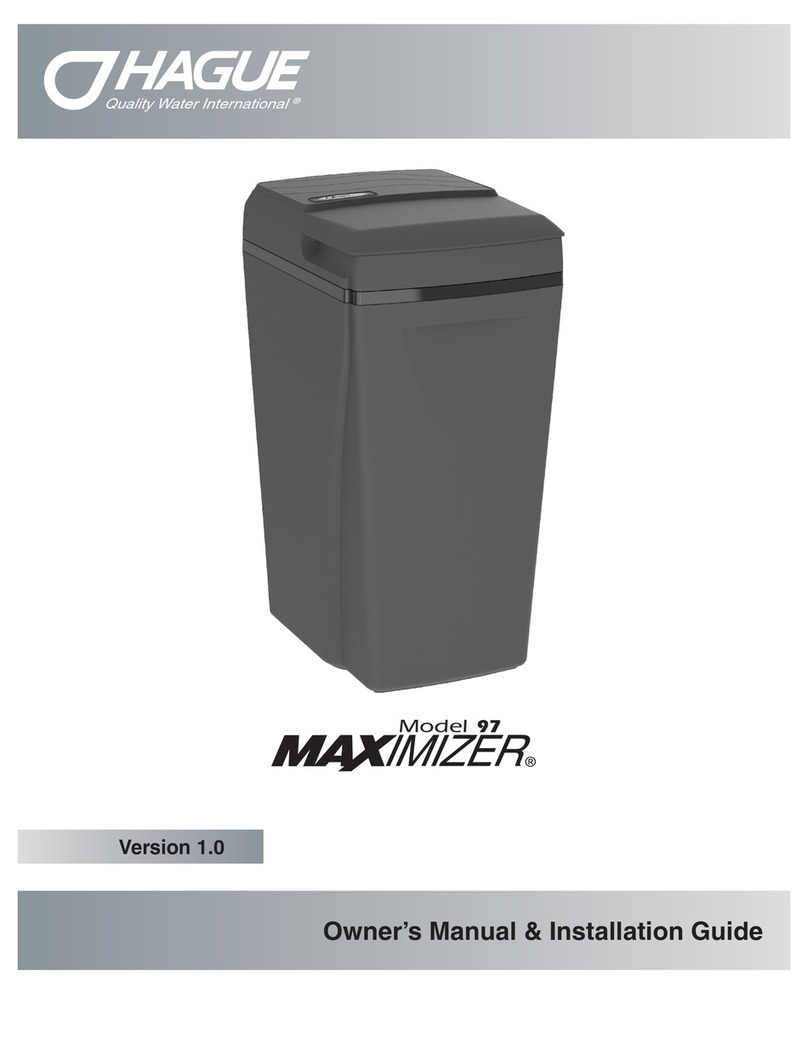Intermountain Water Imperial User manual

Imperial 1.0 - 2.9
Owners Manual
Intermountain Water
Manufacturing Excellence Since 1966
1-800-454-3429

Table of Contents
How your Imperial Water Softener Works 3-9
Your responsibilities as an equipment owner 10
System Programming & Adjustments 11-12
System Diagnostics Mode 13
When & How to Bypass your Imperial Water Softener 14 - 15
System Installation & Startup Procedures 16
Warranty Information 17
This entire publication Copyright © Intermountain Water, Orem UT USA
CLICK HERE TO RETURN TO THE TABLE OF CONTENTS 2

How your Imperial Water Softener Works
Every day, thousands of billions of tons of water evaporate from the
earth's surface.
As the heat of the sun evaporates the water and draws it from the earth's
surface into the atmosphere, many impurities are left behind. The water
vapor eventually cools to form clouds and then falls back to earth as
precipitation. On it's way from the clouds to your faucet, soft rain water
dissolves and absorbs a part of almost everything is passes. The falling
rain cleans the air as it falls. Unfortunately the impurities that were
removed from the air have not left us, they have just been relocated
through the water onto the ground.
Gases and other contaminants cause undesirable tastes, colors and
odors.
Water falls upon the ground, collecting sediments like rust, sand and
algae. The water eventually finds its way to a surface water supply or
percolates downward and collects in an aquifer. As it percolates through
the earth, the water can absorb hardness minerals, iron, heavy metals,
radioactivity, organic contaminants, and many other complex elements
and compounds.
Water can also collect numerous harmful man-made chemical impurities
throughout this cycle. These chemicals are generally odorless, colorless,
tasteless and can often be life-threatening. The statement, "my parents
drank this water for 75 years and it never killed them", is no longer a valid
excuse to not be concerned with water quality.
This entire publication Copyright © Intermountain Water, Orem UT USA
CLICK HERE TO RETURN TO THE TABLE OF CONTENTS 3

There has been a massive global increase in harmful chemical waste over
the last 50 years.
The scientific and medical community has not had time or the ability to
study the long-term health effects of the more than 70,000 harmful
chemicals that can be found in use today.
Approximately 1,000 new synthetic chemical compounds are entering the
industrial marketplace each and every year. Precipitation falls upon
commercial and municipal dumpsites, toxic waste sites, industrial refuse
depots, military test sites, leach fields, mining operations, farmers fields
etc... Where it dissolves minute amounts of the toxic chemicals present
and carries them along.
The United States Government estimated in 1986 that close to two
percent of the nation's ground water supplies were moderately polluted
by sources such as hazardous waste dumps and leaking landfills.
Industrial wastewater is also a major source of water contamination.
When certain chemicals come in contact with others, they create new
compounds.
This entire publication Copyright © Intermountain Water, Orem UT USA
CLICK HERE TO RETURN TO THE TABLE OF CONTENTS 4

Chemicals that are considered generally acceptable in controlled
amounts may react with other elements and/or chemicals to form new
compounds that could be highly carcinogenic.
Chlorine is one of the best-publicized examples; it reacts with organic
matter in water and forms deadly trihalomethanes.
Hard water is probably the single largest threat facing the American
home in the 21st century. Hard water can coat your family, your home
and your appliances with thousands of pounds of inorganic mineral rock-
scale each and every year; Hard water slowly destroys everything it
touches. Left untreated, hard water costs you money, ruins your lifestyle
and can even lower the value of your home.
No one needs to tell you that you're living with Hard Water though. Soap
doesn't lather easily, glasses are cloudy after washing, a ring forms around
the bathtub, faucets and shower heads are crusty, laundering results are
poor and there are many other easily recognized signs.
There are several degrees of Water Hardness. Even if it is moderately
hard, it can seriously damage the plumbing system in your home and, in
time, cause inconvenient and expensive problems.
Hard water is a poor solvent because it is loaded with a variety of
impurities. These dissolved impurities react with certain chemicals found
in soap to form a gummy, insoluble curd.
This soap curd clings stubbornly to everything it touches. The ring around
your bathtub is curd. That same curd causes your hair to become dull
and hard to manage.
Soap curd clogs skin pores and prevents your natural oils from moisturizing
your skin. This dryness causes itching and also aggravates skin conditions
like psoriasis, eczema and acne.
Soap curd is especially noticeable by the scummy film it forms on dishes,
glassware, walls and floors. Hardness and other dissolved solids combine
to form the residue you see as spots on glasses, crockery, cutlery and
shower enclosures.
This entire publication Copyright © Intermountain Water, Orem UT USA
CLICK HERE TO RETURN TO THE TABLE OF CONTENTS 5

Hard water harms fabrics
Laundry washed in hard water takes on a gray color and wears out faster
than expected. With hard water in your washing machine, it's almost
impossible to wash clothes white - even when you use large amounts of
detergent and bleach Minerals and insoluble particles in hard water
trap dirt and soap curd in the fabric of your clothes and linens. These
deposits give fabric a dull gray "washed-out" look and cause the clothing
fibers to be brittle. Your clothes and linens then feel harsh and rough -
they deteriorate faster.
Hard water harms foods
Some vegetables such as peas and beans become tough and
unpalatable when cooked in hard water. Baking with hard water imparts
an undesirable taste from the hardness minerals into your food. Tea,
Coffee and other beverages prepared with hard water taste awful and
often contain flakes of hardness.
Hard water affects your house plumbing
Perhaps the greatest damage done by hard water is the damage that
you can't easily see. Water heaters, humidifiers, boilers and household
pipes become lined with an increasingly thick layer of calcium and
magnesium scale.
As this scale builds up, the water flow in your pipes diminishes to such a
point that new piping is usually the only realistic option to remedy the
situation.
Hard water scale inside a water heater forms an insulating layer that
prevents the burners or heating elements from heating the water
efficiently. Just 1/8" of scale inside the tank can require up to 30% more
fuel to heat the water to the desired temperature.
This entire publication Copyright © Intermountain Water, Orem UT USA
CLICK HERE TO RETURN TO THE TABLE OF CONTENTS 6

How water hardness is measured
Water hardness is measured in imperial Grains per Gallon (gpg). A grain,
in this case, is the weight of an average dry grain of wheat, approximately
1/7000th of a pound. The water treatment industry generally uses the
following standards to classify water hardness.
Soft Water 0 - 0.5 gpg
Slightly Hard Water .5 - 3.5 gpg
Moderately Hard Water 3.5 - 7 gpg
Very Hard Water 7 - 10.5 gpg
Extremely Hard Water 10.5 gpg and greater
THE CRIMES OF HARD WATER
Increased Water Heating Costs
Damaged Clothing
Excessive Soap Consumption
Pipe Scaling
Faucet and Fixture Deterioration
Skin Problems
Unpalatable Food
Undesirable Tastes and Odors
This entire publication Copyright © Intermountain Water, Orem UT USA
CLICK HERE TO RETURN TO THE TABLE OF CONTENTS 7

Principles of Ion Exchange
The smallest units that make up chemical compounds and still retain the
properties of those compounds are called molecules. Molecules are
made up of atoms or groups of atoms. Electrically charged atoms are
called ions. The charge of a single ion can be either positive or negative
- Ions of metals and of hydrogen are usually positively charged and are
called cations. Ions such as chlorine, nitrate, phosphate, fluoride and
sulfates are negatively charged and called anions.
Certain insoluble materials are made up of large ions forming a skeletal
structure containing oppositely charged ions. These ions can be
exchanged with other similar ions in an ion exchange.
The first commercial application of ion exchange was water softening in
1905. Since then, ion exchange has been the most reliable method of
softening water in homes and industry.
The softening of water by ion exchange relies on the replacement of the
calcium and magnesium ions in the water by an equivalent number of
sodium ions.
The softening process may be illustrated by the following equation:-
R2. Na + Ca(HCO3)2 = R2 . Ca + 2NaHCO3
Sodium Ion Exchange
Resin
Calcium Bicarbonate
in water Calcium Ion
Exchange Resin Sodium Bicarbonate
in Water
Obviously, the system can only exchange a certain amount of hardness
and other contaminants. This is referred to as the capacity of the resin.
The capacity of the resin is referred to as grains of calcium carbonate
hardness removed per cubic foot of resin or Milliequivalents per liter.
When the capacity has been exhausted, the resin needs to be
regenerated with a solution of sodium chloride (brine) as follows:-
R2.Ca + 2NaCl = 2 R.Na + CaCl2
Calcium Ion
Exchange Resin Sodium Chloride
Brine Sodium Ion
Exchange Resin Calcium Chloride
Waste
Your Imperial Water Softening System can be regenerated with Potassium
Chloride if desired.
This entire publication Copyright © Intermountain Water, Orem UT USA
CLICK HERE TO RETURN TO THE TABLE OF CONTENTS 8

Over the years, the composition of ion exchange media has advanced,
reflecting global technological advances.
Ion exchange resins used in your Imperial Water Softener are made in the
USA, without harmful toxic solvents. Designed to be physically and
chemically strong while removing the maximum amount of hardness
contamination from water.
The Imperial water softener brand has been trusted by America for more
than 40 years, and continues to provide comprehensive protection from
hard water to an entirely new generation of American families.
This entire publication Copyright © Intermountain Water, Orem UT USA
CLICK HERE TO RETURN TO THE TABLE OF CONTENTS 9

Your responsibilities as an equipment owner
Your Imperial Water Softening System is manufactured to be efficient and
very reliable. To ensure continued performance and keep your system
operating within manufacturer’s specifications, the following operating
conditions must be ensured by you, the equipment owner:
Water Pressure Regulator
The influent water pressure into this water system must be regulated by a
code-compliant pressure-regulating device not to exceed 75psi.
Power Protection
Power to this system must be supplied by an unswitched 110VAC supply.
Surge protection is mandatory and is to be supplied by you, the
equipment owner. The use of a UPS (Uninterruptible Power Supply) is
encouraged.
Salt
This water system uses salt to clean itself. The brine tank must be filled with
a high quality pellet or cubed salt to ensure system operation. Rock salt is
not suitable for this system, as it usually contains high levels of impurities
that can possibly compromise the system functionality.
Hydroclear
The Hydroclear performance injector should be kept full to ensure proper
system operation and maximum efficiency. Check the level of your
Hydroclear feeder each time you fill your brine tank with salt.
Annual Inspection
Water chemistry changes over the years and will have an effect on your
system’s ability to do its job. Natural attrition on the system will usually
occur at 3-5% per year when protected with Hydroclear. Your system
should be inspected and recalibrated annually to ensure your system is
performing at optimum levels and that you stay current with the latest
technologies. Annual inspections are free of charge to Platinum
customers.
This entire publication Copyright © Intermountain Water, Orem UT USA
CLICK HERE TO RETURN TO THE TABLE OF CONTENTS 10

System Programming & Adjustments
The Imperial Water Softening System incorporates a highly sophisticated
microprocessor control system, making it as efficient and reliable as
possible. All system settings are pre-programmed at the factory and then
carefully calibrated by your installer for your exact water chemistry.
Your Imperial Water Softener Control incorporates EEPROM memory and a
24-hour power backup system, which means that your system
programming never has to be reset, even in the event of an extended
power outage.
End-user programming is generally not necessary. If you need to change
programming, the following procedure should be used:-
1. Press the STAR button to enter programming mode.
- Use the UP & DOWN buttons to set the current time of day.
The time of day is very important to the correct operation of
the system.
2. Press the STAR button.
- Use the UP & DOWN buttons to set the current water
hardness level.
The water hardness level should only be changed after
a complete water analysis has been performed.
3. Press the STAR button.
- Use the UP & DOWN buttons to set day override.
The day override setting is designed to help protect your
system from potential bacterial growth. This setting allows
you to choose how often a mandatory regeneration is
performed to ensure that the water is not allowed to
stagnate. 7 Days is the factory recommended setting.
This entire publication Copyright © Intermountain Water, Orem UT USA
CLICK HERE TO RETURN TO THE TABLE OF CONTENTS 11

4. Press the STAR button.
- Use the UP & DOWN buttons to set the regeneration time.
When the system determines that regeneration is necessary, it
will clean itself at the designated regeneration time. During
regeneration, the system bypasses itself automatically from
the house water to protect you from the salt and hydroclear
used during the cleaning process. The regeneration time
should be scheduled during a period of no water usage
activity, such as 2am in the morning.
5. Press the STAR button.
- Within 10 Seconds, system will start a manual regeneration cycle.
This will clean the system and reset the capacity counter.
During a cycle, the individual steps can be interrupted and
advanced to the next step by pressing the STAR button.
Interrupting a regeneration cycle is not recommended.
6. Press the STAR button one more time to exit programming.
This entire publication Copyright © Intermountain Water, Orem UT USA
CLICK HERE TO RETURN TO THE TABLE OF CONTENTS 12

System Diagnostics Mode
System Diagnostic Mode is designed to help you or your Authorized
Intermountain Water Repair Agent understand the dynamics of the
operation of your system.
To enter diagnostics mode, press the UP ARROW for 5 seconds
The system will display various program statistics and settings as
follows: -
Press the STAR button to view the next setting/statistic
Hardness
The hardness setting programmed into the system
Programmed in Grains per Gallons (GPG)
Regen XXX Days ago
The number of days since the system last regenerated.
If 0 (zero) is displayed, then the system cleaned today
In Service XXXX Days
The number of days since the system was originally installed
Number of Regens XXXX
The number of regenerations since the system was installed
Peak Flow xx gpm
The peak rate at which you have ever used water in your
home since installation of the system.
Average Volume XX GL/Day
The average consumption of water per day in your home.
Power Outage XX
The number of power outages sensed by the system since
original installation.
Power Surge/Sage XX
The number of power surges and/or sags since original system
installation.
ImpXXX IMPXX.XX
The system software revision & default program setting code
EXIT Press the UP arrow to exit diagnostics mode or scroll though
the settings again with the STAR button
This entire publication Copyright © Intermountain Water, Orem UT USA
CLICK HERE TO RETURN TO THE TABLE OF CONTENTS 13

When and How to Bypass your Imperial
Water Softener
Your Imperial Water Softening System is supplied with a code compliant
bypass device. This bypass allows the Imperial to be completely isolated
from the household plumbing.
Normal System Operating Mode
Turn the left and right handles so they are parallel with the pipe; and turn
the top handle so it is perpendicular to the pipe as shown below. Water
enters the system on the right side, and exits the system on the left side.
This entire publication Copyright © Intermountain Water, Orem UT USA
CLICK HERE TO RETURN TO THE TABLE OF CONTENTS 14

System Bypass Mode
Turn the left and right handles so they are perpendicular to the pipe; and
turn the top handle so it is parallel to the pipe as shown below. Water
enters the bypass on the right side, and exits the bypass on the left side.
Water does not pass through the system at any time.
When should I bypass my system ?
Your system should be bypassed if any of the following occurs:-
- System leaks
- Unusual noises from system
This entire publication Copyright © Intermountain Water, Orem UT USA
CLICK HERE TO RETURN TO THE TABLE OF CONTENTS 15

System Installation & Startup Procedures
1. Clear the installation area and sweep the area where the brine
tank will be placed.
2. Test home water pressure and make sure it is 75psi static or below.
3. Check to confirm that the water heater has adequate heat
expansion protection to protect the softener from hot water
damage.
4. Connect to house plumbing using code approved methods &
materials and ensure that a bypass device is installed.
5. Install surge protector or UPS for softener.
6. Plug softener in to power.
7. Install 3/8” ID PEX pipe or equivalent to the softener drain fitting and
terminate to drain in a code-approved manner.
8. Connect brine tank to softener using 3/8” OD polytube supplied
with brine tank
9. Bypass Softener.
10. Run bathtub cold to purge piping of debris and chemical residue
from installation, this will take approx. 5 minutes at 3gpm.
11. Leave bathtub running and slowly open the inlet valve to the water
softener.
12. Slowly open the outlet valve from the water softener.
13. Observe flow of water from the bathtub. Water will become a dark
amber color. This color is caused by the system
disinfectant/preservative. Allow water to run until clear. Observe
water for resin particles. If resin particles are found in the water,
immediately bypass the system and call tech-support.
14. Turn off bathtub cold
15. Press the star button to enter programming mode
a. Set the clock with the up & down arrows, then press star
b. Enter the measured water hardness at the installation location,
then press star
c. Enter the anti-bacterial override interval ( 7 is the default), then
press star
d. Set the time of regeneration, then press star
e. The system will countdown for 10 seconds before it begins a
regeneration.
Press star to cancel, or let it begin regeneration.
16. Observe the system during each cycle and advance to the next
cycle by pressing the star button
17. Leave the system in the Refill cycle to fill the brine tank with water.
This entire publication Copyright © Intermountain Water, Orem UT USA
CLICK HERE TO RETURN TO THE TABLE OF CONTENTS 16

Intermountain Water
Limited Lifetime Warranty
1st year of ownership
This residential water system is warranted as to workmanship and material for a period of
one year from date of original installation at the original installation site, if properly
installed by an Intermountain Water Certified Installer. Should any component in your
system prove defective in the first year, it will be repaired, rebuilt or replaced at our
option, provided it is returned directly to us.
After the 1st year of ownership, should any component in your system prove defective
after the first year, it will be repaired, rebuilt or replaced at our option for a maximum
charge of $50.00, provided it is returned directly to us. Labor, transportation, shipping or
other charges incurred in the diagnosis, replacement or repair of defective components
are not covered by this warranty.
If you choose not to send a defective component back to us, repairs to your system can
be conducted in your home by a factory authorized service technician if your home is
within the operating radius of an Intermountain authorized repair center. This warranty
does not cover transportation, shipping, diagnosis, replacement and repair charges
resulting from your in-home repair request.
Intermountain Water or its subsidiaries will not be held responsible for loss or damage
caused by any defective component.
This warranty must be presented at time of claim and all claims must be presented within
30 days of occurrence.
This warranty is void if your water system is not installed in compliance with prevailing
plumbing codes, or if the influent water temperature is hotter than 900F or where the
static water pressure is less than 25psi, or more than 90psi. Intentional/malicious
damage, misuse, neglect, unauthorized modifications or accidental damage to the
system are not covered by this warranty. This warranty does not cover damage caused
by pressure surges, water hammer, power surges or sags, lightning, fire, flood, freezing,
earthquake, acts of God or other casualty.
Your water system is subject to normal wear and tear during its usable service life.
Wear and tear is not regarded as a product defect and is not covered by this warranty.
Your water system includes a Hydroclear performance-enhancing injection system in the
salt tank. The Hydroclear performance-enhancing additive is essential to proper
functioning of your system. If Hydroclear is not added to the injection system at the
prescribed interval in your owner’s manual, this warranty will be void.
This limited lifetime warranty is only valid if registered within 10 days of initial installation.
If unregistered, this warranty is only valid for 1 year from the date of original manufacture.
This entire publication Copyright © Intermountain Water, Orem UT USA
CLICK HERE TO RETURN TO THE TABLE OF CONTENTS 17
Table of contents

